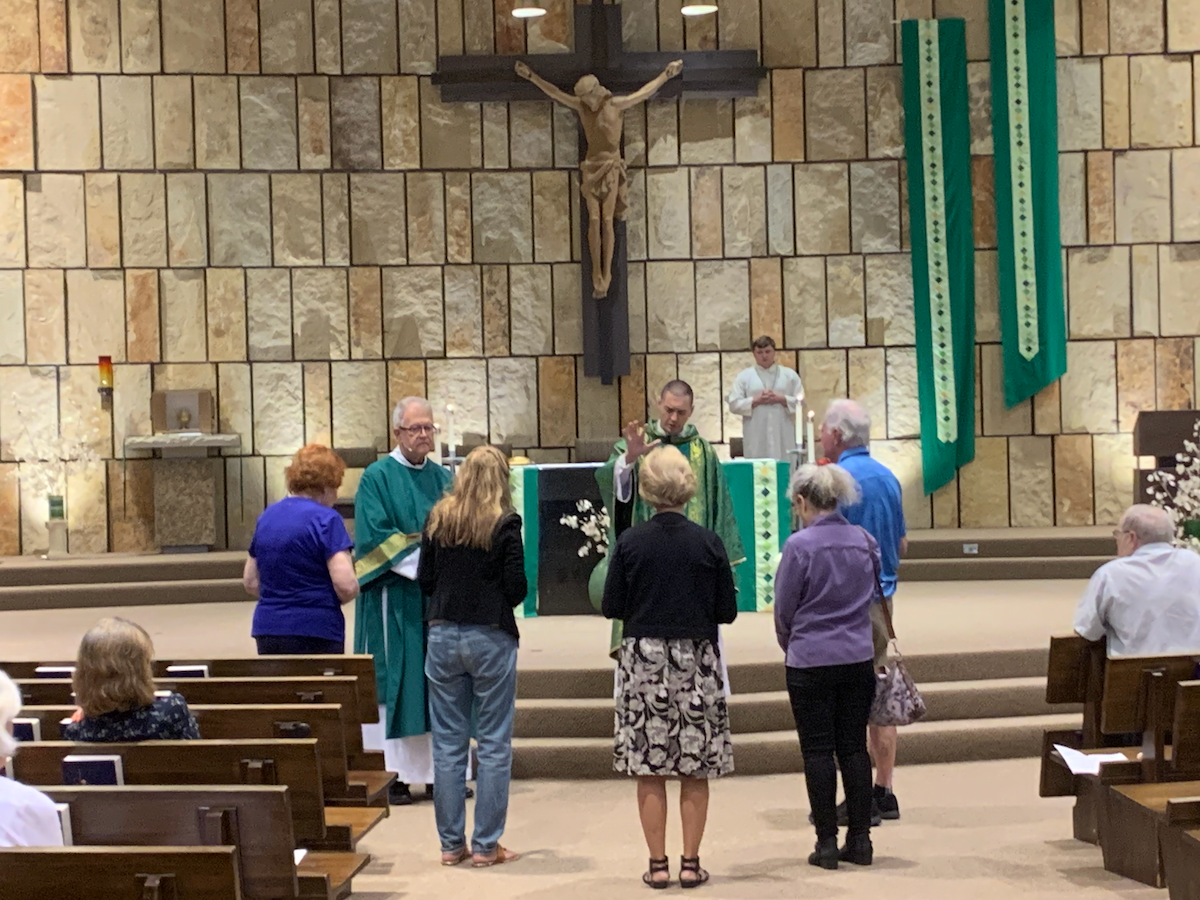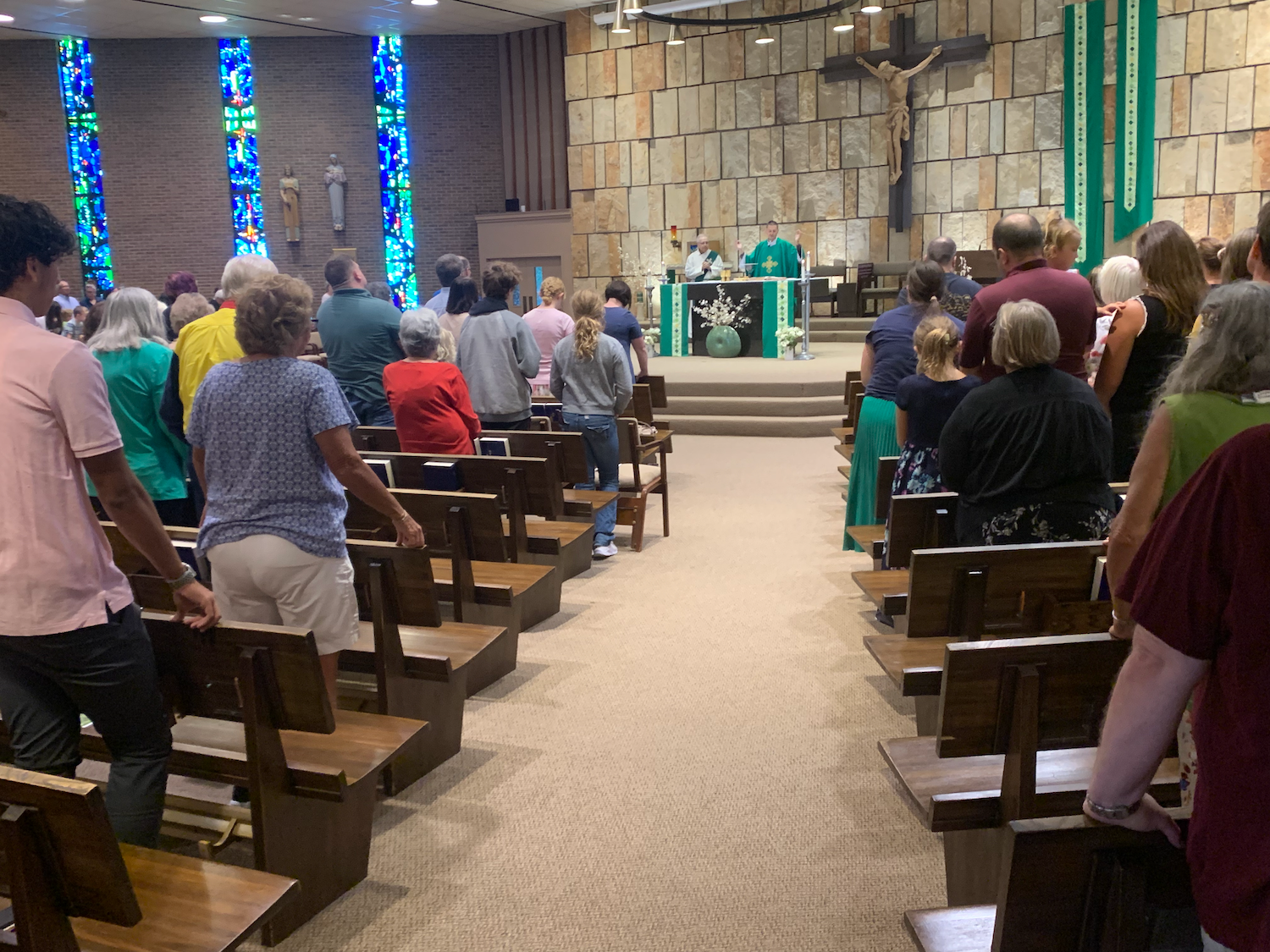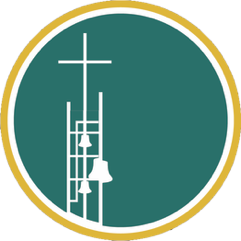Our Sunday services are the celebration of the Mass and include prayers, songs, readings from the Bible and a discussion of those readings. (See more in an explanation on the parts of the Mass by the late Fr. Steve Malkiewicz.)
The Mass is very biblical; all its elements can be found in Scriptures. The form of the Mass can be traced back to the earliest years of the church.
One-Hour Service: The celebration of Mass at St. Joseph lasts from 55 to 65 minutes. While wish all could stay until the end of our celebration, some people do leave Mass early. You are encouraged to stay until the priest and other ministers process out of church.
Who’s Up There? The priest is the principle celebrant of the Mass; he is acting "in persona Christi" - in the person of Christ. He is assisted by male and female altar servers and a deacon and, occasionally, the sacristan. Those people will be on the altar area of the church during the entire Mass. Selected members of the congregation will go to the altar area to proclaim those readings. The cantor will do the same for certain songs and sung prayers. Communion distributors will gather around the altar before taking their distribution stations. The tabernacle to the left of the altar houses reserved hosts which are the true Body of Christ and, as such, is to be respected as the presence of God.
Sing Along: We are a singing parish, with some traditional and some newer songs, along with some that could be termed in the “praise” genre. A cantor leads the congregation in song, as well as sung prayers, and a choir sings during certain times of the year. Accompanying instruments include piano, organ, drums, guitar, trumpet, bells and violin.
Guidebooks and Aids: If you are not familiar with the order of Mass, the blue books in the pew racks can guide you. Also in the pews are worship aids with additional music and the Anima Christi prayer, which is said after Communion.
Kneeling and Standing:
Our pews contain kneelers; we kneel during traditional kneeling times of the Mass; members of other religions and people with health problems may sit during the kneeling times. We believe kneeling is a sign of respect to God, and note the scriptural call that "At the name of Jesus, every knee should bend." We stand during the reading of the Gospel and at other times, such as during the recitation of the creed. If you are visiting from a church where kneeling is not common, you are welcome to sit during those times.
Spontaneous:
Don’t be surprised if, moved by the Spirit, people start clapping during some point of the Mass.
Catholics-to-Be:
In the months before Easter, a group of people studying to become Roman Catholic will leave Mass mid-point to reflect on the Word of God as proclaimed during the first half of Mass.
Children’s Readings:
During the school year, young people will leave during the readings so they can participate in a youth-oriented segment of the Mass.
Youth Mass:
During the school year, youth from our parish participate in a special way at the 10:30 a.m. Mass once a month, serving as lectors, ushers and greeters. More contemporary music is part of that Mass.
Baptisms:
Occasionally we’ll have a baptism within Mass, a special blessing, such as for students, teachers, or those preparing for the sacraments.
Collection:
Collection baskets are passed person-to-person down each pew. The collection is used to support the various ministries and operations of the church, including charitable outreach. Once a month we collect food and money for food pantries. Occasionally, a second collection will be taken for a missionary or some other need.
Hand-shaking:
After praying the Lord’s Prayer – the Our Father, we exchange a sign of peace. If you are not comfortable shaking hands for health reasons, a wave, nod or other gesture is appropriate.
Bells Are Ringing: During the Eucharist Prayer, bells are rung at three ocassions to call attention to the sacred moments when the bread and wine become the Body and Blood of Christ.
Communion:
Roman Catholics not in a state of serious sin, and members of the Eastern Orthodox churches, the Assyrian Church of the East, and the Polish National Catholic Church, are welcome to join us in Communion, but should follow the guidance of their own church. We use real wine, and — as Scriptures teach — believe the bread and wine to be totally transformed into the Body and Blood, Soul and Divinity of Christ.
If you will not receive Communion, you are encouraged to join the Communion line with your arms crossed across your chest; the distributor will give you a blessing.
At Communion time, ministers will bring the Body of Christ to various stations in the front of both levels of the church. We process from the pews to the distributor, and follow the practice of gently bowing before reverently receiving the Sacrament. The Body of Christ may be received in the hand or can be placed directly into your mouth. The cup with the Blood of Christ is offered to communicants in the center aisle of the mail floor. After wiping the rim of the cup, the distributor will offer it to the communicant to take a sip. It is not proper to dip the host into the cup (intinction).
What to Wear:
We encourage respectful dress for Mass and other liturgies and services, but you will find people attired in shorts and t-shirts to suits and ties.
Have a Question?
We often have someone in the Welcome Center to answer questions after Mass. Before Mass, welcome ministers at church entrances can answer your questions. If you have a need during Mass, including a need for medical attention, ushers in each section can assist you.
Why Bother Going to Mass?
Listen to Fr. Matt Ruhl's sermon to find out why.



